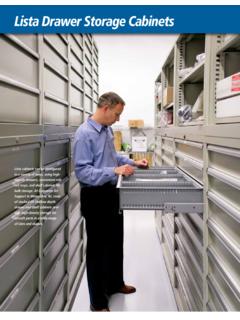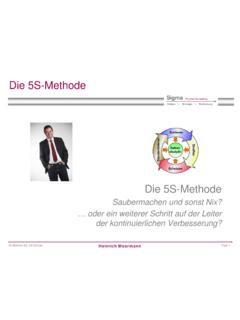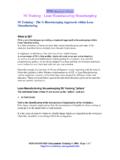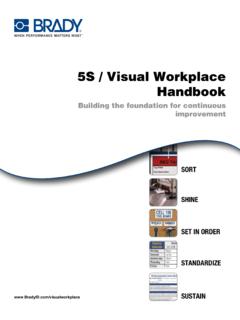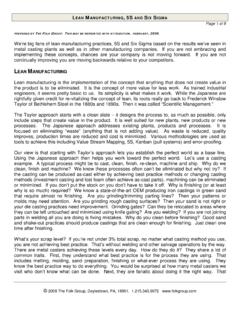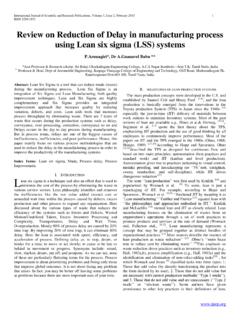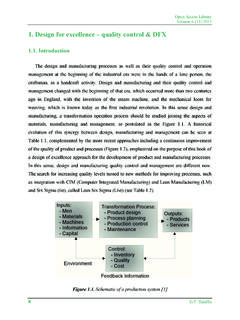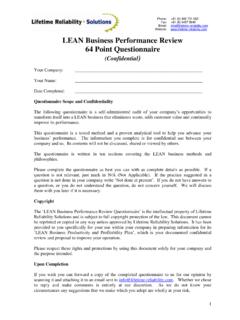Transcription of Implementing 5S Workplace Organization …
1 Many manufacturing facilities have opted tofollow the path towards a 5S Workplace organi-zational and housekeeping methodology as partof continuous improvement or lean manufactur-ing processes. 5S is a system to reduce waste and optimizeproductivity through maintaining an orderlyworkplace and using visual cues to achieve moreconsistent operational results (see chart on page3). The term refers to five steps sort, set inorder, shine, standardize, and sustain that arealso sometimes known as the 5 pillars of a visualworkplace. 5S programs are usually implementedby small teams working together to getmaterials closer to operations, right atworkers fingertips and organized andlabeled to facilitate operations with thesmallest amount of wasted time 5S system is a good startingpoint for all improvement efforts aim-ing to drive out waste from the manu-facturing process, and ultimatelyimprove a company s bottom line byimproving products and services, andlowering costs.
2 Many companies areseeking to making operations moreefficient, and the concept is especially attractiveto older manufacturing facilities looking toimprove the bottom line by reducing their costs. A place for everything, and everything in itsplace is the mantra of the 5S method, and stor-age and workspace systems such as those provid-ed by Lista International allow improved organi-zation and maximum use of cubic space for thehighest density storage. The result is an improvedmanufacturing process and the lowest overall costfor goods produced. The 5 Pillars of a Visual Workplace Implementing the 5S method means cleaningup and organizing the Workplace in its existingconfiguration. It is typicallythe first lean method thatorganizations lean method encour-ages workers to improvetheir working conditionsand helps them to learn toreduce waste, unplanneddowntime, and typical 5S implemen-tation would result in sig-nificant reductions in thesquare footage of spaceneeded for existing opera-tions.
3 It also would result in the Organization oftools and materials into labeled and color codedImplementing 5S Workplace Organization MethodologyPrograms In manufacturing FacilitiesConsolidating stored items into the smallestpossible footprint yields benefits rangingfrom more efficient use of space, faster andeasier retrieval and an improved locations, as well as kits that containjust what is needed to perform a task. The 5S methodology is a simple and universalapproach that works in companies all over theworld. It is essentially a support to such othermanufacturing improvements as just-in-time (JIT)production, cellular manufacturing , total qualitymanagement (TQM), or six sigma initiatives, andis also a great contributor to making the work-place a better place to spend time.
4 Table 1 (page 3) provides an overview of the5 pillars, with a brief definition of what the stepmeans in a manufacturing context, why it simportant, and the list of problems it avoids ifimplemented. Benefits to the company from using the 5 Smethodology include raising quality, loweringcosts, promoting safety, building customer confi-dence, increasing factory up-time, and loweringrepair 5S methodology is typically implementedusing a 3-step process, which includes establishinga cross func-tional team(includingemployeesthat work inthe associatedareas), tour-ing all areasassociatedwith manu-facturing process under review, and brainstorm-ing on ways to improve Organization to reducewaste. For example, factories have more thantheir share of searching waste.
5 It is not unusualfor a three hour changeover routine to include 30minutes of searching. When attempting to reducechangeover time radically (for example, goingfrom 3 hours to 10 minutes), there is clearly noroom for 30 minutes of searching stream mapping (VSM) can be used inthe 5S process to analyze the material, process,and information flow. The information is used todevelop a current state map, which sets out howthings have been done in the past. The team thenanalyzes the current state map to identify oppor-tunities for Workplace Organization and house-keeping improvements. A wide range of ideas isconsidered while all ideas won t end up beingviable, all are worthy of investigation. The key isto observe non value added processes and createan environment to promote value added workthrough waste elimination.
6 Finally, the team envisions a future statebased on the exercise and begins implementingthe future state. The process is iterative; thefuture state becomes the current state, and a con-tinuous improvement process should be used toidentify new ways to reduce waste. Waste isdefined very broadly, and includes things likewaste in the movement of material, carrying toomuch inventory, defects or rework, producingscrap, waiting or unnecessary examples include waste of motionbecause the person sent to get a part or toolcould not find it; searching waste because no onecan find the key to the locked cabinet that con-tains needed tools; waste of defective productsbecause defective parts were not separated prop-erly and used by mistake.
7 And even waste causedby unsafe conditions, as boxes of supplies that areleft in a walkway, causing someone to trip andget INTERNATIONAL 5S Workplace ORGANIZATIONF ewer steps and greater Organization mean less teams work closely together to plan the greatest efficiency and productivity in operations and INTERNATIONAL 5S Workplace ORGANIZATIONT able 1 The Pillars of 5 SPillarWhat does it mean?Why is it important?What problems are avoided?Sort Remove all items not needed forcurrent production operations. Leave only the bare essentials:When in doubt, throw it out. Space, time, money, energy, andother resources can be managedand used most effectively. Reduces problems and annoy-ances in the work flow.
8 Improves communicationbetween workers. Increases product quality. Enhances productivity. The factory becomes increasinglycrowded and hard to work in. Storage of unneeded items gets inthe way of communication. Time wasted searching forparts/tools. Unneeded inventory and machin-ery are costly to maintain. Excess stock hides productionproblems. Unneeded items and equipmentmake it harder to improve theprocess in order Arrange needed items so that theyare easy to use. Label items so that anyone canfind them or put them away. Eliminates many kinds of waste,including: Searching waste. Waste due to difficulty inusing items. Waste due to difficulty inreturning items.
9 Motion waste. Searching waste. Waste of human energy. Waste of excess inventory. Waste of defective products. Waste of unsafe Integrates Sort, Set in Order, andShine into a unified whole. By ensuring conditions do notdeteriorate to former state, facil-itates implementation of thefirst three pillars. Conditions go back to their oldundesirable levels. Work areas are dirty and clut-tered. Tool storage sites become disor-ganized and time wasted search-ing for tools. Clutter starts to accumulate overtime. Backsliding Keep everything, every day, sweptand clean. Turn the Workplace into a cleanbright place where everyone willenjoy working.
10 Keep thing in a condition so it isready to be used when needed. Lack of sunlight can lead to poormorale and inefficient work. Defects are less obvious. Puddles of oil and water causeslipping and injuries. Machines that do not receive suf-ficient maintenance tend to breakdown and cause Making a habit of properly main-taining correct procedures. Instill discipline necessary to avoidbacksliding. Consequences of not keeping tothe course of action greater thanconsequences of keeping to it. Unneeded items begin piling up. Tools and jigs do not get returnedto their designated places. No matter how dirty equipmentbecomes, nothing is done to cleanit. Items are left in a hazardous ori-entation.



